Listening for Integrated STEM Discourse: Power and Positioning in a Teacher Professional Development Dataset Activity
Abstract
:1. Introduction
2. Literature Review
2.1. Integrated STEM
2.2. STEM and Technology
2.3. Authentic STEM
2.4. Sensemaking vs. the “Classroom Game”
2.5. Equity and Gender
2.6. Partnerships and Mentoring
3. Theoretical Framework: Feminist Social Constructivism
4. The Study: Materials, Methods, and Analysis
4.1. The Gap in the Literature
4.2. Research Questions
- How do in-service STEM teachers in a PD activity position themselves with respect to each other, and how does their use of the computer reflect their positioning?
- How does the technology use of these in-service teachers fit into definitions of technology within STEM?
- What does in-service teacher discourse during the PD reveal about integrating STEM disciplines?
4.3. Sample and Setting
4.4. Materials and Experimental Procedure
- Population unlikely to know IDL, Python, etc., so programming not a feasible option.
- Goal of the project is examining dataset skills, not programming skills.
- Google Sheets makes it easier to create histograms than MS Excel.
4.5. Data Sources
4.6. Analysis
4.7. Limitations
5. Results
5.1. Benjamin: The Mentor Teacher
Benjamin: That would be my question. If you hand this to a student, some of them, they don’t have, if they have an idea of magnitude, they would basically say—so brightness is the same on all these? Zero is a value of magnitude.
Benjamin: Why does right ascension go to 359? It shouldn’t. It should only go for 24 h.
[other discussion]
Benjamin: So 90 degrees should be roughly… 9 h. Let’s find something that’s close to that, like 12 h. That should be close to 180 degrees. So there it is.
Benjamin: A surveyor’s scope, which is what the orange lines [show], is going to change all day long because the Earth is rotating. We can’t do astronomy like that because we have to have— tell me where it is in the sky every single time. And that’s what the blue lines are. The right ascension and the declination.
Benjamin: So the blue lines are like latitude and longitude on a regular [globe].
5.2. Isaac: The Second-in-Command
Benjamin: The other thing I guess you could do, you could go through and say if we plotted all these, we could find out where, what section of the sky this was taken in. But it does from, what, 2 down to what?
Isaac: 360 dec.
Benjamin: We looked completely in a circle. We looked from plus 0 down to −0 zero, This plus 0 is going to be the North Pole. Minus zero is going to roughly be the South Pole. So are we looking at all sections of the sky?
Isaac: You’re talking about declination?
Benjamin: Yep.
Erica: Is that why these are negative? Negative numbers are in the southern hemisphere?
Isaac: —above our…
Benjamin: The negative numbers would be in the celestial southern hemisphere. Not our southern hemisphere.
Isaac: —above the celestial equator or below the celestial equator?
Isaac: They just ordered this table according to right ascension. They could have done it according to declination. And if they would have—well, we did sort it by declination—oops. If we order it by declination, luckily the right ascension is attached to it and it automatically adjusts. Now you can see the right ascension is all gobbledygook order.
Erica: Those are really high numbers. Why are they—Oh, because you said that’s going around.
[Benjamin and Isaac both talking at once] full circles
Isaac: These, if it’s basically a hemisphere, be zero to 90, but it’s not quite the full [sphere]—
Benjamin: So that would be the next thing I would notice.
Isaac: Not quite the full hemisphere?
5.3. Erica: The Learner and Go-Between
Erica: …make them [her students] do data like on the spreadsheet and then just create 25 of those, instead of having 200 to deal with.
Erica: Yeah, you guys spent all that time looking for trends or you were looking for correlations between one variable and another. And you couldn’t find any. I’m not sure what the word “trend” is referring to. Is it just a pattern with the numbers or a trend of actual science happening with these quasars? That word “trend” means something different to me.
Erica: So if I was doing this in class with younger kids in science, I’d want them to be using terms like columns and the rows and say the words and actually [be] writing down the RA and declination. Especially if I was going to put this as a writing assignment. Want to be sure I had a list of all the vocabulary I’d want them to use or or even a science writing paragraph. I would also have had those vocabulary words.
5.4. Olivia and Brittany: The Unknowns in the Back
Benjamin: So without graphing it, what would you say about this then?
Brittany: We just talked about each individual category as you guys were discussing it. What is ______. So we have values from 2 to 359 ________ very few have jets [inaudible]
Benjamin: So you just write up a summary?
Olivia: Summarized each category.
5.5. The Group Dynamic
Benjamin: I was going to show you, if we can step away from this a minute. If this has got you confused—
Erica: Yes, it is.
Benjamin: —go back to Stellarium. So that you understand what those numbers are. So this is an astronomy program. If you hold your mouse and let’s click on the cloud and turn the sun off. So this is like the night sky from a certain location. If we strip away the atmosphere, this is what it would look like.
Benjamin: If I turn on this one, this is called the equatorial grid. This is the RA and the dec. If you just drag your screen down, it should take you all the way up and see what it’s laid off of, how it’s laid out. It’s laid off—
Isaac: North Star.
Benjamin: It’s all laid off the North Star. Okay. So some kid might ask you-- and if you notice, it’s got these units of degrees, of 11 h, 12 h. So the hours are really like longitude lines and the degrees of declination are like latitude lines.
Erica: Can you go to real places on the Earth?
Benjamin: Yes, you can. But here’s something I want to show you. Most kids might try to tie this to what’s called 0 to 360 degrees like you see in a surveyor’s scope.
5.6. The Role of the Computer
5.7. The Bathroom Break: The Exception That Proves the Rule
Erica: So, the best graph that we noticed would have been the redshift. Sense of it. Its distance away.
Brittany: Like _________ taking ____ and mapping it out ______ coordinates with the RA and dec. Then ____ each point, with its redshift values _____ additional object. Then either color code or somehow label if it had _________ radio magnitude or __________ just kind of simplify some of the data. And that’s what I did. __ at all.
Brittany: I don’t know [Google Sheets]. Maybe Excel.
Brittany: I don’t know. We were having a hard time with this. We were thinking of our 4th graders and how to connect this while you guys are actually analyzing—[laughter]
Benjamin: How would you?
Brittany: I don’t know. The only thing that we talked about was like mapping the data out since you would have the coordinates with the RA and the dec. Then just label each point with its redshift value since the original object… seeing that number. Then maybe color coding, it has radio magnitude or it doesn’t, just using different colors. Then they can map them out and see where they’re falling on the map. So they have that visual.
5.8. Integrated STEM Discourse
Isaac: You’ve got ascension and declination both, so how are you going to plot it to both? We did plot against right ascension; we plotted against declination separately. But to go one, you’d have to do range plotting though some of the histograms do that for you. But I tried to change the range on one of them the bar width and it wouldn’t let me. So, whatever. That’s exactly where I was going to go next, was go broader or go narrower on that and see if there was a trend there, but it wouldn’t let us.
6. Discussion and Conclusions
6.1. Question 1: Positioning
6.2. Question 2: Use of Technology in STEM
6.3. Question 3: Integrated STEM
6.4. Summary
7. Future Research
8. Implications
- Confront this hierarchy, and there are approaches to this end.
- Assign teachers to work in smaller groups (fewer than five individuals) which may encourage all individuals to participate and thus reduce the “unknowns in the back” phenomenon.
- Assign homogeneous groups, that is, single sex, similar years of experience, age group of their students, and subject areas, which may reduce the formation of power structures based on these characteristics; however, it does not directly challenge these power structures, and there may be other reasons to prefer assigning heterogeneous groups, or allowing self-selection of groups.
- Arrange activities including the use of computers with one computer per one teacher, however this is not an option for all PD instructors, and even if it is an option, doing so may negatively impact collaboration between the teachers. If PD is taking place over a prolonged period (such as multiple days, whether contiguous or with gaps between the days), the teachers could be encouraged to rotate who controls the computer on each day.
Author Contributions
Funding
Institutional Review Board Statement
Informed Consent Statement
Data Availability Statement
Acknowledgments
Conflicts of Interest
References
- Hill, C.; Corbett, C.; St Rose, A. Why So Few?: Women in Science, Technology, Engineering, and Mathematics; AAUW: Boston, MA, USA, 2010. [Google Scholar]
- Microsoft. Why Europe’s Girls Aren’t Studying STEM; Microsoft Philanthropies: Redmond, WA, USA, 2017. [Google Scholar]
- Berwick, C. Keeping Girls in STEM: 3 Barriers, 3 Solutions. 2019. Available online: https://www.edutopia.org/article/keeping-girls-stem-3-barriers-3-solutions (accessed on 26 October 2021).
- Shapiro, M.; Grossman, D.; Carter, S.; Martin, K.; Deyton, P.; Hammer, D. Middle School Girls and the “Leaky Pipeline” to Leadership. Middle Sch. J. 2015, 46, 3–13. [Google Scholar] [CrossRef]
- Burrows, A.C.; Borowczak, M.; Myers, A.; Schwortz, A.C.; McKim, C. Integrated STEM for teacher professional learning and development: “I need time for practice”. Educ. Sci. 2021, 11, 21. [Google Scholar] [CrossRef]
- Schwortz, A.C.; Burrows, A.C. Authentic science experiences with STEM datasets: Post-secondary results and potential gender influences. Res. Sci. Technol. Educ. 2020, 39, 347–367. [Google Scholar] [CrossRef]
- Bailey, J.M. Astronomy Education Research: Developmental History of the Field and Summary of the Literature; National Research Council Board on Science Education: Washington, DC, USA, 2011. [Google Scholar]
- Tesfaye, C.L.; White, S. High School Physics Teacher Preparation; American Institute of Physics: College Park, MD, USA, 2012. [Google Scholar]
- Physics Teacher Education Coalition (PhysTEC). The Shortage of Physics Teachers. 2020. Available online: https://phystec.org/teacher-shortage (accessed on 29 August 2021).
- Committee on STEM Education. Charting a Course for Success: America’s Strategy for STEM Education; National Science & Technology Council: Washington, DC, USA, 2018.
- Council of Chief State School Officers. Common Core State Standards Math; National Governors Association Center for Best Practices: Washington, DC, USA, 2010. [Google Scholar]
- National Research Council. Next Generation Science Standards: For States, by States; National Academies Press: Washington, DC, USA, 2013. [Google Scholar]
- Achieve. Connecting Science Standards with Assessment: A Snapshot of three Countries’ Approaches—England, Hong Kong, and Canada; Achieve: Washington, DC, USA, 2010. [Google Scholar]
- Achieve. International Science Benchmarking Report: Taking the Lead in Science Education: Forging Next-Generation Science Standards; Achieve: Washington, DC, USA, 2010. [Google Scholar]
- Gao, X.; Li, P.; Shen, J.; Sun, H. Reviewing assessment of student learning in interdisciplinary STEM education. Int. J. STEM Educ. 2020, 7, 24. [Google Scholar] [CrossRef]
- Struyf, A.; De Loof, H.; Boeve-de Pauw, J.; Van Petegem, P. Students’ engagement in different STEM learning environments: Integrated STEM education as promising practice? Int. J. Sci. Educ. 2019, 41, 1387–1407. [Google Scholar] [CrossRef]
- Guzey, S.S.; Caskurlu, S.; Kozan, K. Integrated STEM pedagogies and student learning. In Handbook of Research on STEM Education; Johnson, C.C., Mohr-Schroeder, M.J., Moore, T.J., English, L.D., Eds.; Taylor & Francis: New York, NY, USA, 2020; pp. 65–75. [Google Scholar]
- Moore, T.J.; Johnston, A.C.; Glancy, A.W. STEM integration: A synthesis of conceptual frameworks and definitions. In Handbook of Research on STEM Education; Johnson, C.C., Mohr-Schroeder, M.J., Moore, T.J., English, L.D., Eds.; Taylor & Francis: New York, NY, USA, 2020; pp. 3–16. [Google Scholar]
- Jackson, C.; Tank, K.M.; Appelgate, M.H.; Jurgenson, K.; Delaney, A.; Erden, C. History of integrated STEM curriculum. In Handbook of Research on STEM Education; Johnson, C.C., Mohr-Schroeder, M.J., Moore, T.J., English, L.D., Eds.; Taylor & Francis: New York, NY, USA, 2020; pp. 169–183. [Google Scholar]
- Burrows, A.; Slater, T. A Proposed Integrated STEM Framework for Contemporary Teacher Preparation. Teach. Educ. Pract. 2015, 28, 318–330. [Google Scholar]
- Thuy, N.T.T.; Bien, N.V.; Quy, D.X. Fostering Teachers’ Competence of the Integrated STEM Education. J. Penelit. Dan Pembelajaran IPA 2020, 6, 166. [Google Scholar] [CrossRef]
- Abello, J.; Pardalos, P.; Resende, M. (Eds.) The Preface. In Handbook of Massive Data Sets; Kluwer Academic Publishers: Dordrecht, The Netherlands, 2002. [Google Scholar]
- Brunner, R.J.; Djorgovski, S.G.; Prince, T.A.; Szalay, A.S. Massive datasets in astronomy. In Handbook of Massive Data Sets; Abello, J., Pardalos, P., Resende, M., Eds.; Kluwer Academic Publishers: Dordrecht, The Netherlands, 2002. [Google Scholar]
- Leskovec, J.; Rajaraman, A.; Ullman, J.D. Mining of Massive Datasets; Cambridge University Press: Cambridge, UK, 2011. [Google Scholar]
- Campbell, T.; Abd-Hamid, N.H. Technology use in science instruction (TUSI): Aligning the integration of technology in science instruction in ways supportive of science education reform. J. Sci. Educ. Technol. 2013, 22, 572–588. [Google Scholar] [CrossRef]
- Cheruvelil, K.S.; Soranno, P.A. Data-Intensive Ecological Research Is Catalyzed by Open Science and Team Science. BioScience 2018, 68, 813–822. [Google Scholar] [CrossRef]
- Anderson, J.O.; Lin, H.S.; Treagust, D.F.; Ross, S.P.; Yore, L.D. Using large-scale assessment datasets for research in science and mathematics education: Programme for International Student Assessment (PISA). Int. J. Sci. Math. Educ. 2007, 5, 591–614. [Google Scholar] [CrossRef]
- Berg, C.; Boote, S. Format Effects of Empirically Derived Multiple-Choice Versus Free-Response Instruments When Assessing Graphing Abilities. Int. J. Sci. Math. Educ. 2017, 15, 19–38. [Google Scholar] [CrossRef]
- Gültepe, N. Reflections on high school students’ graphing skills and their conceptual understanding of drawing chemistry graphs. Kuram Uygul. Egit. Bilimleri 2016, 16, 53–81. [Google Scholar] [CrossRef]
- Jackson, D.F.; Edwards, B.J.; Berger, C.F. Teaching the design and interpretation of graphs through computer-aided graphical data analysis. J. Res. Sci. Teach. 1993, 30, 483–501. [Google Scholar] [CrossRef]
- Wallace, R.M.C.; Kupperman, J.; Krajcik, J.; Soloway, E. Science on the web: Students online in a sixth-grade classroom. J. Learn. Sci. 2000, 9, 75–104. [Google Scholar] [CrossRef]
- Kilty, T.J. Technology Integration and Science Education: An Instructional Design and Technology Perspective. University of Wyoming. 2019. Available online: https://search-proquest-com.libproxy.uwyo.edu/docview/2385176771?accountid=14793 (accessed on 24 September 2020).
- Reiser, R.A. What Field Did You Say You Were in? Defining and Naming Our Field. In Trends and Issues in Instructional Design and Technology, 3rd ed.; Reiser, R.A., Dempsey, J.V., Eds.; Pearson: Boston, MA, USA, 2012; pp. 1–7. Available online: http://catalogue.pearsoned.ca/assets/hip/us/hip_us_pearsonhighered/samplechapter/0132563584.pdf (accessed on 17 October 2020).
- Ng, O.-L.; Shi, L.; Ting, F. Exploring differences in primary students’ geometry learning outcomes in two technology-enhanced environments: Dynamic geometry and 3D printing. Int. J. STEM Educ. 2020, 7, 50. [Google Scholar] [CrossRef]
- K-12 Computer Science Framework. 2016. Available online: http://www.k12cs.org (accessed on 17 October 2020).
- Krauss, J.; Prottsman, K. Computational Thinking and Coding for Every Student: The Teacher’s Getting Started Guide; Corwin Press: Thousand Oaks, CA, USA, 2018. [Google Scholar]
- Heron, P.; McNeil, L. Phys21: Preparing Physics Students for 21st-Century Careers; Joint Task Force on Undergraduate Physics Programs: College Park, MD, USA, 2016. [Google Scholar]
- AAPT UCTF. AAPT Recommendations for Computational Physics in the Undergraduate Physics Curriculum. Ameri-can Association of Physics Teachers. 2016. Available online: https://www.aapt.org/Resources/upload/AAPT_UCTF_CompPhysReport_final_B.pdf (accessed on 5 March 2019).
- 40 Ridgway, R. Building Bridges with Computational Thinking|NSTA. Available online: https://www.nsta.org/science-scope/science-scope-aprilmay-2020/building-bridges-computational-thinking (accessed on 17 October 2020).
- Wiebe, E.; Kite, V.; Park, S. Integrating computational thinking in STEM. In Handbook of Research on STEM Education; Johnson, C.C., Mohr-Schroeder, M.J., Moore, T.J., English, L.D., Eds.; Taylor & Francis Group: New York, NY, USA, 2020; pp. 196–209. Available online: https://ebookcentral.proquest.com/lib/uwy/reader.action?docID=6186714 (accessed on 25 October 2020).
- Hjalmarson, M.A.; Holincheck, N.; Baker Courtney, K.; Galanti, T.M. Learning models and modeling across the STEM disciplines. In Handbook of Research on STEM Education; Johnson, C.C., Mohr-Schroeder, M.J., Moore, T.J., English, L.D., Eds.; Taylor & Francis: New York, NY, USA, 2020; pp. 223–233. [Google Scholar]
- National Research Council. New Worlds, New Horizons in Astronomy and Astrophysics; National Research Council: Washington, DC, USA, 2010. Available online: http://sites.nationalacademies.org/bpa/bpa_049810 (accessed on 20 November 2018).
- Resnick, I.; Kastens, K.A.; Shipley, T.F. How students reason about visualizations from large professionally collected data sets: A study of students approaching the threshold of data proficiency. J. Geosci. Educ. 2018, 66, 55–76. [Google Scholar] [CrossRef]
- Hsu, P.-S.; Sharma, P. A case study of enabling factors in the technology integration change process. J. Educ. Technol. Soc. 2008, 11, 213–228. [Google Scholar]
- Kersaint, G.; Ritzhaupt, A.D.; Liu, F. Technology to enhance mathematics and science instruction: Changes in teacher perceptions after participating in a yearlong professional development program. J. Comput. Math. Sci. Teach. 2013, 33, 73–101. [Google Scholar]
- Morrell, P.; Rogers, M.P.; Pyle, E.; Roehrig, G.; Veal, W. 2020 NSTA/ASTE Standards for Science Teacher Preparation; National Science Teaching Association: Arlington, VA, USA, 2020. [Google Scholar]
- Burrows, A.C.; DiPompeo, M.A.; Myers, A.D.; Hickox, R.C.; Borowczak, M.; French, D.A.; Schwortz, A.C. Authentic science experiences: Pre-collegiate science educators’ successes and challenges during professional development. Probl. Educ. 21st Century 2016, 70, 59–73. [Google Scholar] [CrossRef]
- Spuck, T. Putting the “authenticity” into science learning. In Einstein Fellows: Best Practices in STEM Education; Spuck, T., Leigh, J., Eds.; Peter Lang: New York, NY, USA, 2014; pp. 118–157. [Google Scholar]
- Gao, S.; Wang, J.; Zhong, Z. Influence of science instruction reform on academic performance of eighth grade students in Chinese inner-Mongolia autonomous region. Comp. J. Comp. Int. Educ. 2018, 48, 879–895. [Google Scholar] [CrossRef]
- Odden, T.O.; Russ, R.S. Defining sensemaking: Bringing clarity to a fragmented theoretical construct. Sci. Educ. 2019, 103, 187–205. [Google Scholar] [CrossRef] [Green Version]
- Weick, K.E.; Sutcliffe, K.M.; Obstfeld, D. Organizing and the process of sensemaking. Organ. Sci. 2005, 16, 409–421. [Google Scholar] [CrossRef] [Green Version]
- Coburn, C.E. Collective sensemaking about reading: How teachers mediate reading policy in their professional communities. Educ. Eval. Policy Anal. 2001, 23, 145–170. [Google Scholar] [CrossRef] [Green Version]
- Vygotsky, L. Mind in Society: The Development of Higher Psychological Processes; Harvard University Press: Cambridge, MA, USA, 1978. [Google Scholar]
- Reeves, T.C. The classroom game. Acad. Quest. 2001, 14, 21–30. [Google Scholar] [CrossRef]
- Hutchison, P.; Hammer, D. Attending to student epistemological framing in a science classroom. Sci. Educ. 2010, 94, 506–524. [Google Scholar] [CrossRef]
- März, V.; Kelchtermans, G. Sensemaking and structure in teachers’ reception of educational reform. A case study on statistics in the mathematics curriculum. Teach. Teach. Educ. 2013, 29, 13–24. [Google Scholar] [CrossRef]
- Spillane, J.P.; Reiser, B.J.; Reimer, T. Policy implementation and cognition: Reframing and refocusing implementation research. Rev. Educ. Res. 2002, 72, 387–431. [Google Scholar] [CrossRef] [Green Version]
- Buck, G.A.; Francis, D.C.; Wilkins-Yel, K.G. Research on gender equity in STEM education. In Handbook of Research on STEM Education; Johnson, C.C., Mohr-Schroeder, M.J., Moore, T.J., English, L.D., Eds.; Taylor & Francis: New York, NY, USA, 2020; pp. 289–299. [Google Scholar]
- Wade-Jaimes, K. ‘STEM girls should be’: A discourse analysis of school structures and their impact on African American, middle school girls’ positioning in science. Discourse Stud. Cult. Politics Educ. 2020, 42, 828–839. [Google Scholar] [CrossRef]
- Dancy, M.; Rainey, K.; Stearns, E.; Mickelson, R.; Moller, S. Undergraduates’ awareness of White and male privilege in STEM. Int. J. STEM Educ. 2020, 7, 52. [Google Scholar] [CrossRef]
- Corbett, C.; Hill, C. Solving the Equation: The Variables for Women’s Success in Engineering and Computing; AAUW: Washington, DC, USA, 2015. [Google Scholar]
- Ellis, J.; Fosdick, B.K.; Rasmussen, C. Women 1.5 Times More Likely to Leave STEM Pipeline after Calculus Compared to Men: Lack of Mathematical Confidence a Potential Culprit. PLoS ONE 2016, 11, e0157447. [Google Scholar] [CrossRef]
- Riegle-Crumb, C.; King, B.; Grodsky, E.; Muller, C. The more things change, the more they stay the same? Prior achievement fails to explain gender inequality in entry into STEM college majors over time. Am. Educ. Res. J. 2012, 49, 1048–1073. [Google Scholar] [CrossRef] [Green Version]
- Stearns, E.; Bottia, M.C.; Giersch, J.; Mickelson, R.A.; Moller, S.; Jha, N.; Dancy, M. Do Relative Advantages in STEM Grades Explain the Gender Gap in Selection of a STEM Major in College? A Multimethod Answer. Am. Educ. Res. J. 2020, 57, 218–257. [Google Scholar] [CrossRef]
- Ball, C.; Huang, K.-T.; Rikard, R.V.; Cotten, S.R. The emotional costs of computers: An expectancy-value theory analysis of predominantly low-socioeconomic status minority students’ STEM attitudes. Inf. Commun. Soc. 2019, 22, 105–128. [Google Scholar] [CrossRef] [Green Version]
- Day, J.; Stang, J.B.; Holmes, N.G.; Kumar, D.; Bonn, D.A. Gender gaps and gendered action in a first-year physics laboratory. Phys. Rev. Phys. Educ. Res. 2016, 12, 020104. [Google Scholar] [CrossRef]
- Stoilescu, D.; Egodawatte, G. Gender differences in the use of computers, programming, and peer interactions in computer science classrooms. Comput. Sci. Educ. 2010, 20, 283–300. [Google Scholar] [CrossRef]
- Corp, A.; Fields, M.; Naizer, G. Elementary STEM teacher education: Recent practices to prepare general elementary teachers for STEM. In Handbook of Research on STEM Education; Johnson, C.C., Mohr-Schroeder, M.J., Moore, T.J., English, L.D., Eds.; Taylor & Francis: New York, NY, USA, 2020; pp. 337–348. [Google Scholar]
- Burrows, A.C. Secondary Teacher and University Partnerships: Does Being in a Partnership Create Teacher Partners?—ProQuest. Retrieved 15 February 2016. 2011. Available online: http://search.proquest.com.libproxy.uwyo.edu/docview/894265674?pq-origsite=summon (accessed on 15 February 2016).
- Schwortz, A.C.; Burrows, A.C.; Guffey, S.K. Mentoring partnerships in science education. Educ. Action Res. 2017, 25, 630–649. [Google Scholar] [CrossRef] [Green Version]
- Burrows, A.C. Partnerships: A Systemic Study of Two Professional Developments with University Faculty and K-12 Teachers of Science, Technology, Engineering, and Mathematics. Probl. Educ. 21st Century 2015, 65, 28–38. Available online: http://journals.indexcopernicus.com/abstract.php?icid=1163178 (accessed on 16 October 2018). [CrossRef]
- Lefever-Davis, S.J. Two sides of a partnership: Egalitarianism and empowerment in school-university partnerships. J. Educ. Res. 2007, 100, 204–210. [Google Scholar] [CrossRef]
- Stringer, H. Navigating the Power Differential. GradPSYCH 2016, 14, 35–37. Available online: https://www.apa.org/gradpsych/2016/01/power-differential (accessed on 26 October 2021).
- McVee, M.B. Postitioning theory: Affordances for educational researchers. In Sociocultural Positioning in Literacy: Exploring Culture, Discourse, Narrative, & Power in Diverse Educational Contexts; McVee, M.B., Brock, C.H., Glazier, J.A., Eds.; Hampton Press, Inc.: Cresskill, NJ, USA, 2003; pp. 1–21. [Google Scholar]
- Harré, R.; Van Lagenhove, L. Introducing positioning theory. In Positioning Theory: Moral Contexts of Intentional Action; Harré, R., Van Lagenhove, L., Eds.; Blackwell Publishing Ltd.: Oxford, UK, 1999; pp. 14–31. [Google Scholar]
- Wieselmann, J.R.; Keratithamkul, K.; Dare, E.A.; Ring-Whalen, E.A.; Roehrig, G.H. Discourse Analysis in Integrated STEM Activities: Methods for Examining Power and Positioning in Small Group Interactions. Res. Sci. Educ. 2020, 51, 113–133. [Google Scholar] [CrossRef]
- McVee, M.B.; Swenson, J.; English, K.; Shanahan, L. A review of theory and methods for sociocultural research in science and engineering education. J. Adolesc. Adult Lit. 2020, 64, 360–363. [Google Scholar] [CrossRef]
- Koro-Ljungberg, M.; Yendol-Hoppey, D.; Smith, J.J.; Hayes, S.B. (E)pistemological Awareness, Instantiation of Methods, and Uninformed Methodological Ambiguity in Qualitative Research Projects on JSTOR. Educ. Res. 2009, 39, 687–699. [Google Scholar] [CrossRef]
- Gee, J.P. How to Do Discourse Analysis: A Toolkit; Routledge: New York, NY, USA, 2011. [Google Scholar]
- Roychoudhury, A.; Tippins, D.J.; Nichols, S.E. Gender-inclusive science teaching: A feminist-constructivist approach. J. Res. Sci. Teach. 1995, 32, 897–924. [Google Scholar] [CrossRef]
- Riger, S. Epistemological debates, feminist voices: Science, social values, and the study of women. Am. Psychol. 1992, 47, 730–740. [Google Scholar] [CrossRef]
- Godec, S. Sciencey girls: Discourses supporting working-class girls to identify with science and its potential for examining social equity issues in science education. Educ. Sci. 2018, 8, 19. [Google Scholar] [CrossRef] [Green Version]
- Fiaccadori, E. The Question of ‘Nature’: What Has Social Constructionism to Offer Feminist Theory? Goldsmiths; University of London: London, UK, 2006. [Google Scholar]
- Creswell, J.W. Qualitative Inquiry & Research Design: Choosing Among Five Approaches; SAGE Publications: Los Angeles, CA, USA, 2013. [Google Scholar]
- Stake, R. The Art of Case Study; SAGE Publications: Thousand Oaks, CA, USA, 1995. [Google Scholar]
- Ellis, J.; Wieselmann, J.; Sivaraj, R.; Roehrig, G.; Dare, E.; Ring-Whalen, E. Toward a productive definition of technology in science and STEM education. Contemp. Issues Technol. Teach. Educ. 2020, 20, 472–496. [Google Scholar]
- Burrows, A.C.; Swarts, G.P.; Hutchison, L.; Katzmann, J.M.; Thompson, R.; Freeman, L.; Schanke, A.; Kilty, T.; Reynolds, T. Finding spaces: Teacher education technology competencies (TETCs). Educ. Sci. 2021, 11, 733. [Google Scholar] [CrossRef]
- Ntemngwa, C.; Oliver, J.S. The implementation of integrated science technology, engineering and mathematics (STEM) instruction using robotics in the middle school science classroom. Int. J. Educ. Math. Sci. Technol. 2018, 6, 12–40. [Google Scholar] [CrossRef] [Green Version]
- Thibaut, L.; Ceuppens, S.; De Loof, H.; De Meester, J.; Goovaerts, L.; Struyf, A.; Boeve-de Pauw, J.; Dehaene, W.; Deprez, J.; De Cock, M.; et al. Integrated STEM Education: A Systematic Review of Instructional Practices in Secondary Education. Eur. J. STEM Educ. 2018, 3, 2. [Google Scholar] [CrossRef]
- Yildirim, B.; Sahin-Topalcengiz, E.; Arikan, G.; Timur, S. Using Virtual Reality in the Classroom: Reflections of STEM Teachers on the Use of Teaching and Learning Tools. J. Educ. Sci. Environ. Health 2020, 6, 231–245. [Google Scholar] [CrossRef]
- Schneider, D.P.; Hall, P.B.; Richards, G.T.; Strauss, M.A.; Vanden Berk, D.E.; Anderson, S.F.; Brandt, W.N.; Fan, X.; Jester, S.; Gray, J.; et al. The Sloan Digital Sky Survey Quasar Catalog. IV. Fifth Data Release. Astron. J. 2007, 134, 102–117. [Google Scholar] [CrossRef] [Green Version]
- Shen, Y.; Richards, G.T.; Strauss, M.A.; Hall, P.B.; Schneider, D.P.; Snedden, S.; Bizyaev, D.; Brewington, H.; Malanushenko, V.; Malanushenko, E.; et al. A catalog of quasar properties from Sloan Digital Sky Survey Data Release 7. Astrophys. J. Suppl. Ser. 2011, 194, 45. [Google Scholar] [CrossRef]
- Åkerblom, D.; Lindahl, M. Authenticity and the relevance of discourse and figured worlds in secondary students’ discussions of socioscientific issues. Teach. Teach. Educ. 2017, 65, 205–214. [Google Scholar] [CrossRef]
- Bazzul, J. Critical discourse analysis and science education texts: Employing Foucauldian notions of discourse and subjectivity. Rev. Educ. Pedagog. Cult. Stud. 2014, 36, 422–437. [Google Scholar] [CrossRef]
- Doran, Y.J. The Discourse of Physics: Building Knowledge through Language, Mathematics and Image; Routledge: New York, NY, USA, 2018. [Google Scholar]
- Hao, J. Analyzing Scientific Discourse from a Systemic Functional Linguistic Perspective: A Framework for Exploring Knowledge Building in Biology; Routledge: New York, NY, USA, 2020. [Google Scholar]
- Kranzfelder, P.; Bankers-Fulbright, J.L.; García-Ojeda, M.E.; Melloy, M.; Mohammed, S.; Warfa, A.R. The Classroom Discourse Observation Protocol (CDOP): A quantitative method for characterizing teacher discourse moves in undergraduate STEM learning environments. PLoS ONE 2019, 14, e0219019. [Google Scholar] [CrossRef] [Green Version]
- Lee, S.C.; Irving, K.E. Development of two-dimensional Classroom Discourse Analysis Tool (CDAT): Scientific reasoning and dialog patterns in the secondary science classes. Int. J. STEM Educ. 2018, 5, 5. [Google Scholar] [CrossRef]
- Tofel-Grehl, C.; Callahan, C.M.; Nadelson, L.S. Comparative analyses of discourse in specialized STEM school classes. J. Educ. Res. 2017, 110, 294–307. [Google Scholar] [CrossRef] [Green Version]
- Volkwyn, T.S.; Airey, J.; Gregorcic, B.; Heijkenskjöld, F. Transduction and science learning: Multimodality in the physics laboratory. Des. Learn. 2019, 11, 16–29. [Google Scholar] [CrossRef]
- Paulus, T.; Lester, J. Using ATLAS.ti for a discourse analysis study of blogging in an educational context. In Proceedings of the ATLAS.ti User Conference 2013: Fostering Dialog on Qualitative Methods, ATLAS.ti User Conference, Berlin, Germany, 12–14 September 2013. [Google Scholar]
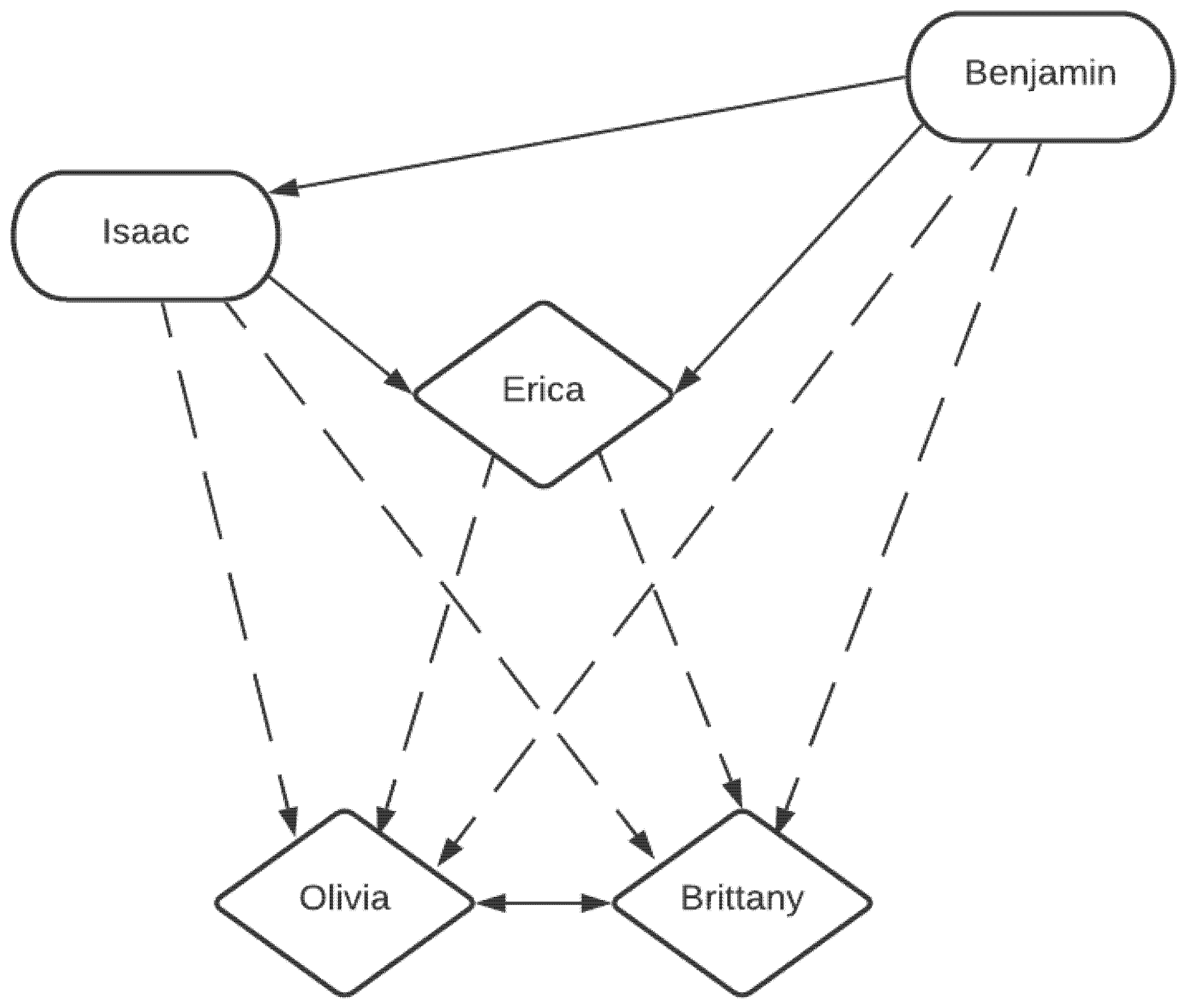
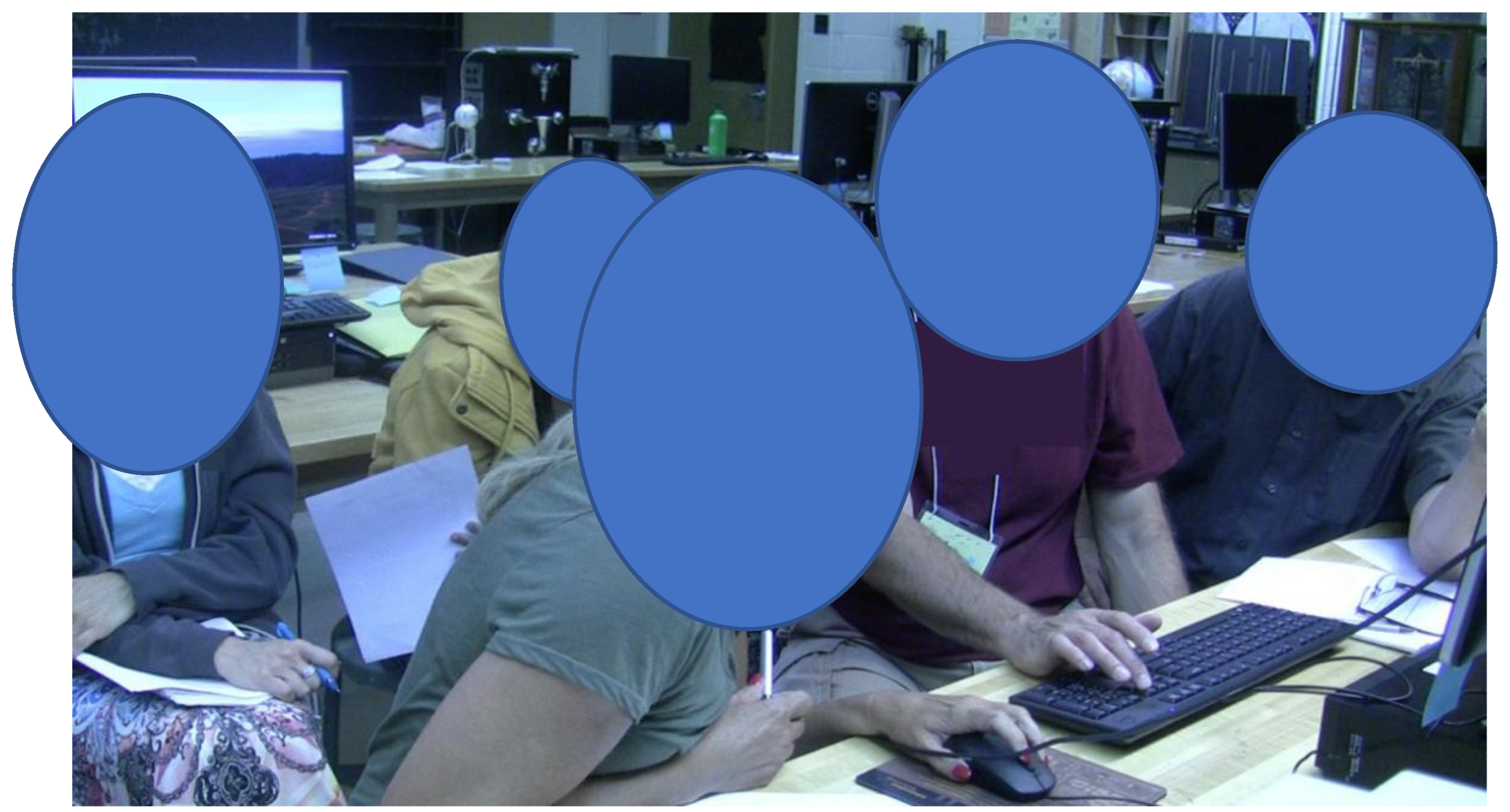
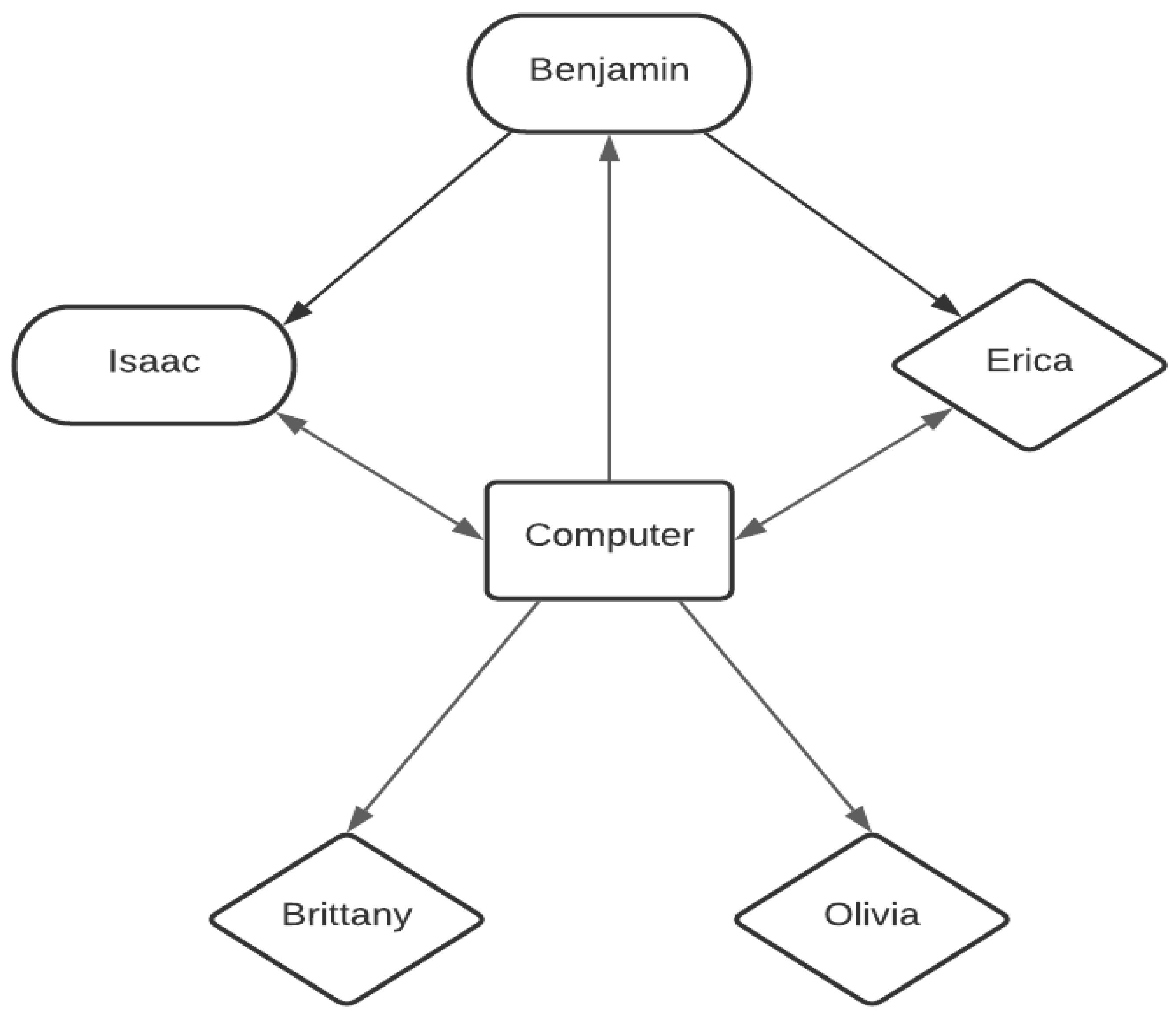
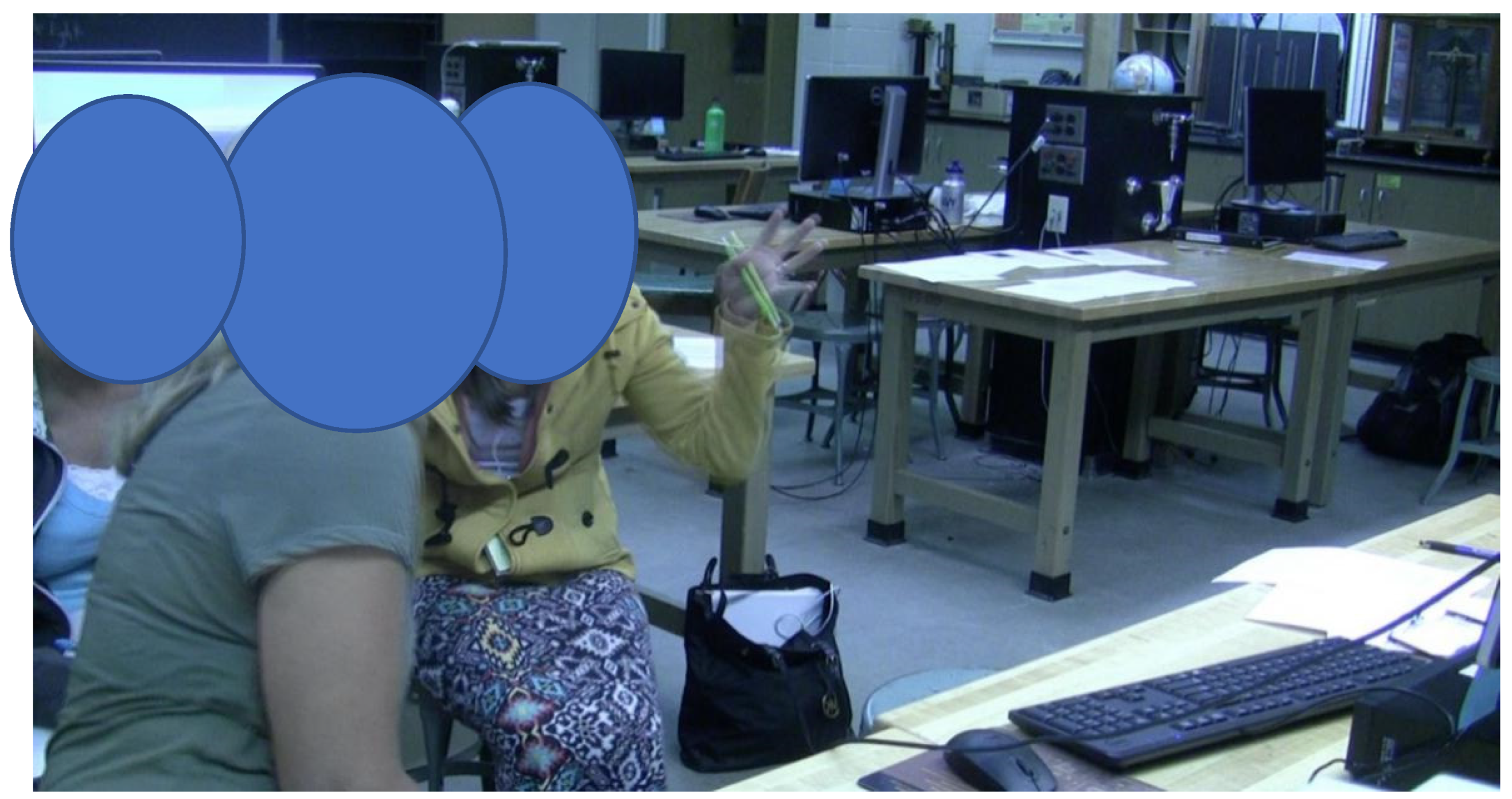
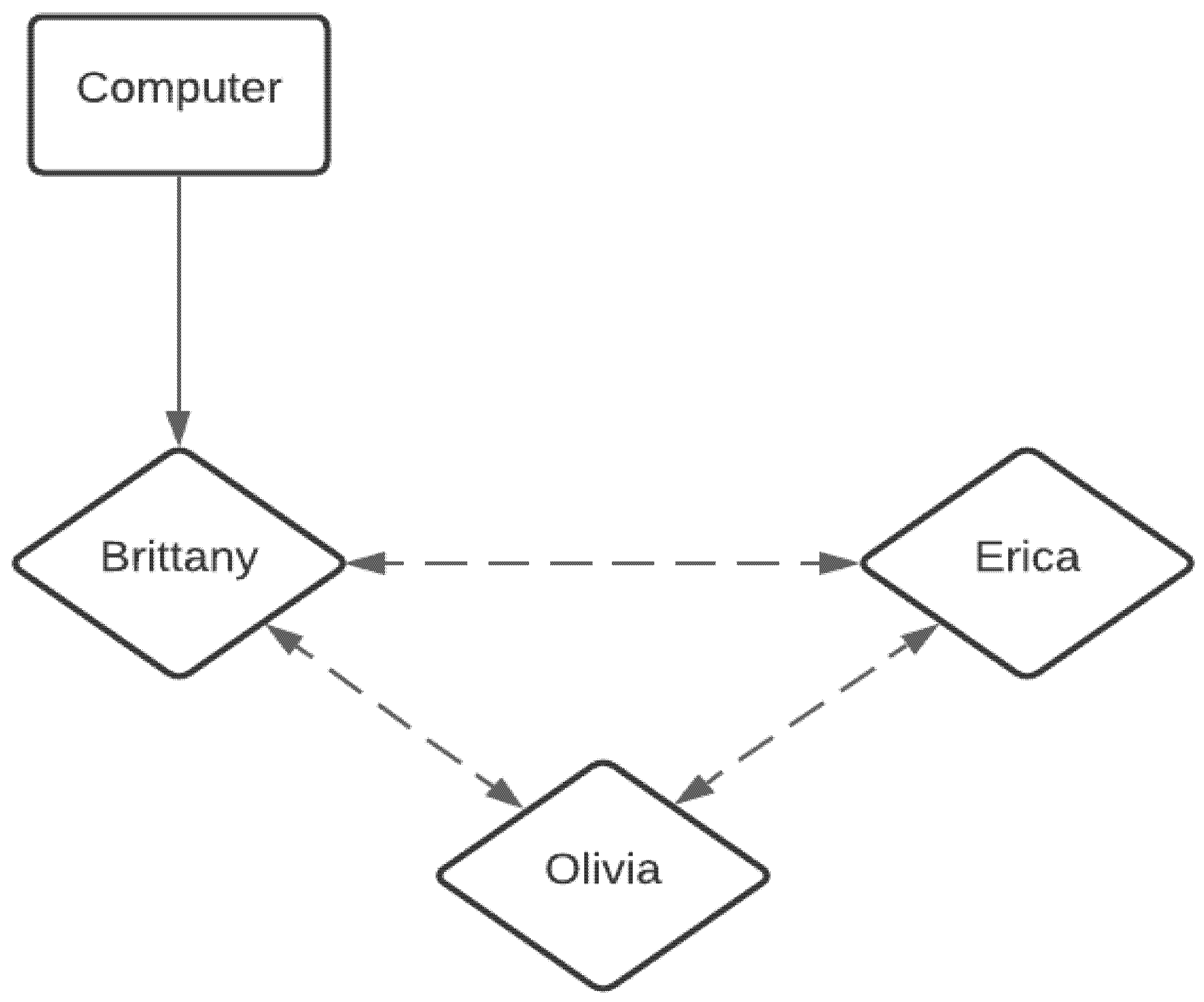
| Name (Pseudonym) | Sex/Gender | Education | STEM Teacher Experience |
|---|---|---|---|
| Benjamin | Male | 3 Bachelor’s degrees | 10 years science, plus public outreach at NASA |
| Isaac | Male | Bachelor’s degree + 40 graduate credits | 21 years math |
| Erica | Female | Bachelor’s degree + graduate credits | Elementary and middle school math |
| Olivia | Female | Bachelor’s degree | Elementary school 1 year |
| Brittany | Female | Bachelor’s degree | 1 year STEM |
| Codes and Subcodes |
|---|
|
|
|
|
|
|
|
|
|
|
|
| Quote | Integrated STEM Elements |
|---|---|
| Benjamin: It’s all laid off the North Star. Okay. So, some kid might ask you—and if you notice, it’s got these |
|
| Isaac: They just |
|
| Erica: So if I was doing this in class with younger kids in science, I’d want them to be using terms like |
|
| Brittany: We talked about was like |
|
Publisher’s Note: MDPI stays neutral with regard to jurisdictional claims in published maps and institutional affiliations. |
© 2022 by the authors. Licensee MDPI, Basel, Switzerland. This article is an open access article distributed under the terms and conditions of the Creative Commons Attribution (CC BY) license (https://creativecommons.org/licenses/by/4.0/).
Share and Cite
Schwortz, A.C.; Burrows, A.C. Listening for Integrated STEM Discourse: Power and Positioning in a Teacher Professional Development Dataset Activity. Educ. Sci. 2022, 12, 84. https://doi.org/10.3390/educsci12020084
Schwortz AC, Burrows AC. Listening for Integrated STEM Discourse: Power and Positioning in a Teacher Professional Development Dataset Activity. Education Sciences. 2022; 12(2):84. https://doi.org/10.3390/educsci12020084
Chicago/Turabian StyleSchwortz, Andria C., and Andrea C. Burrows. 2022. "Listening for Integrated STEM Discourse: Power and Positioning in a Teacher Professional Development Dataset Activity" Education Sciences 12, no. 2: 84. https://doi.org/10.3390/educsci12020084







